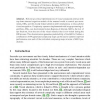Free Online Productivity Tools
i2Speak
i2Symbol
i2OCR
iTex2Img
iWeb2Print
iWeb2Shot
i2Type
iPdf2Split
iPdf2Merge
i2Bopomofo
i2Arabic
i2Style
i2Image
i2PDF
iLatex2Rtf
Sci2ools
WAPCV
2004
Springer
2004
Springer
Combining Conspicuity Maps for hROIs Prediction
Bottom-up cortical representations of visual conspicuity interact with top-down internal cognitive models of the external world to control eye movements, EMs, and the closely linked attention-shift mechanisms; to thus achieve visual recognition. Conspicuity operators implemented with image processing algorithms, IPAs, can discriminate human Regions-of-Interest, hROIs, the loci of eye fixations, from the rest of the visual stimulus that is not visited during the EM process. This discrimination generates predictability of the hROIs. Further, a combination of IPA-generated conspicuity maps can be used to achieve improved performance over each of the individual composing maps in terms of hROI predictions.
| Added | 02 Jul 2010 |
| Updated | 02 Jul 2010 |
| Type | Conference |
| Year | 2004 |
| Where | WAPCV |
| Authors | Claudio M. Privitera, Orazio Gallo, Giorgio Grimoldi, Toyomi Fujita, Lawrence W. Stark |
Comments (0)

